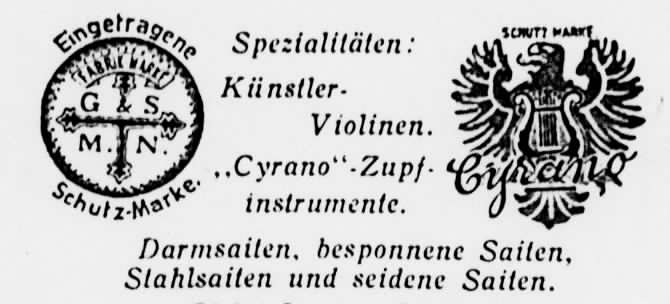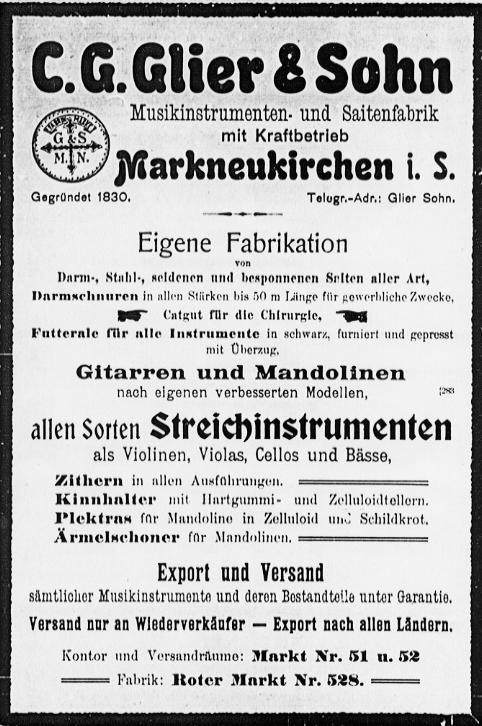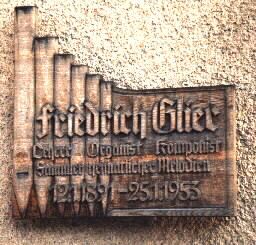
|
At the turn of
the century the company August Clemens
Glier was well known. After the death of August Clemens (1897) his sons Paul
and Otto took over the company. After Otto's death in 1914, Paul continued as
the sole owner. A valvewinghorn (so-called Kuhlohorn) from August Clemens Gliers
production can be found in a collection of the Museum for Musicinstruments in
Berlin. This special form was developed by means of the priest D. Johannes Kuhlo
of Bethel (Institute of Bodelschwing in Bielefeld) for the prostestant trombone
choir. |
|
Since 1893 up to 1929/30 the stringmaking factory of C. G. Glier and sons, founded 1830, did commercials for their products in Paul de Wit's "Worldaddressbook of the industry of music instruments". Zoebisch writes on page 130 concerning the company C. G. Glier, that the founder could not be traced. The magazine "Zeitschrift für Instrumentenkunde" (ZfI 51th year, page 86/87) writes on behalf of the 100-year existence of the company in 1931 that Christian Gottfried Glier (* 1781+1855) has been the founder. After the church register entries he was a tanner and tax inspector. However, founder could also have been his brother, the string maker and trader of musical instruments Christian Gottlob Glier (* 1787 +1858). In 1838 Christian Gottfried Glier (* 1817 + 1878), the son of the tanner Christian Gottfried Glier married the daughter of his uncle Christian Gottlob, Christiane Wilhelmine. The son mentioned in the company name would be in that case the son-in-law of Christian Gottlob. Son and son-in-law at the same time is Christian Gottfried Glier (* 1817+1878). In the second generation the company is in his hands. After another two generations of family property Max Adler purchased the company on November 8th, 1809.  |
 |
|
The
following postcard addressed to Osmar Reinhold Glier (* 1857
+ 1940) gives evidence on how far the trade was spreaded throughout the
world. He was a brother of August Clemens Glier. On this card missionary Göhring
from Cameroon complained that with the delivery of school-violins half a dozen
tuning-pegs were missing. |

|
Also multi-language commercials are an evidence for the world wide trading. (see picture below):

 |
 |
The composer
Hermann
Friedrich Glier
Hermann
F. Glier, born 1891 in Markneukirchen, was son of the double bass and cello
maker Hermann Glier. With 10 years of age he learned playing the violin and
piano. He obtained the basics for his later educational and artistic work on a
teacher training college in Plauen. After WW1 he started his activities as a
teacher in his hometown Markneukirchen. Beside his teaching post, which ended
1945, he gave piano lessons up to his last years of life. After WW2 he was a
teacher for religious education (R.E.) working for the church and at the same
time he was an organist at the Nicolai-church in Markneukirchen. Friedrich Glier
worked as a composer, too. His opus-list contained 86 opusnumbers. A
commemorative plaque for the teacher, musician and composer Friedrich Glier can
be found on the house of his father in the Breite Straße 1 in Markneukirchen.
 |
The
city of Markneukirchen named one of its streets after Friedrich Glier:
|
If more information are
needed about Markneukirchen
or the Musical
Instruments Museum in the
"Glierhaus am Bienengarten", renamed Paulus-Schössel (Paulus-castle)
, please use the link. This side contains
further links (some only German!). A visit to Markneukirchen is certainly worth the
time.
|

